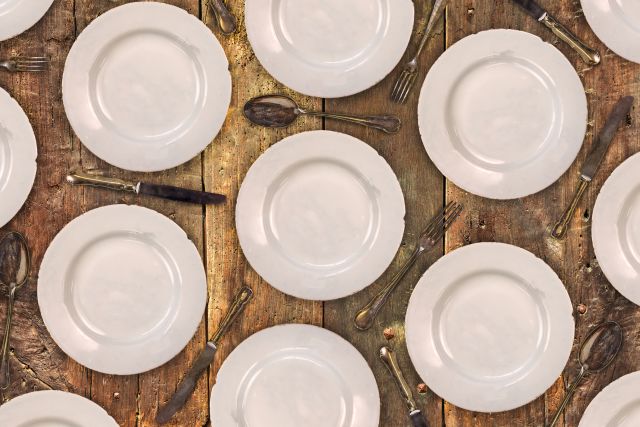Updated on September 25, 2024.
If you’re trying to manage your weight, the traditional breakfast-lunch-dinner meal format is not your only option. The 2020 Dietary Guidelines Advisory Committee’s scientific report makes it clear that three factors of eating behavior closely influence each other—the types of foods you eat, the amount of food you eat, and how often you eat.
Eating more than three meals each day will affect how foods are digested and metabolized.
There’s no single “best” option for everyone, as there are no clear answers from research into meal frequency.
Here are the pros and cons of different meal formats, plus healthy eating habits you can try with whatever meal frequency you choose.
3 meals per day
Pro:
- Thermic effect of food (TEF). TEF is a measure of how much your metabolic rate goes up after a meal. According to a 2019 review in the Journal of the American College of Nutrition, eating fewer but larger meal sizes raises TEF more than frequent small meals. A higher TEF means more energy is burned after a meal. The review also noted that eating carbs, protein, and low-fat plant-based foods, and avoiding dietary fat, also contributed to higher TEF.
Con:
- Blood sugar drops. With three meals a day, meals may end up happening more than four hours apart, which for some people can cause blood sugar levels to drop too low. When this happens, it can get tempting to reach for unhealthy snacks in order to satisfy hunger. Grabbing a quick high-carbohydrate snack may bring your blood sugar level up too quickly, after which it could crash down once again, leaving you searching for more food.
4 or more meals per day
Pros:
- Stability. Eating many small meals throughout the day—as long as the meals are balanced—can help stabilize your blood sugar, so you don’t get energy highs and lows.
- Better cholesterol. One 2019 study published in the journal Neuroendocrinology Letters found that eating four or more meals each day may be linked to higher HDL (the “good” cholesterol) than achieved by eating three or fewer meals.
- Symptom relief. Limited studies suggest small, frequent meals may help improve digestive symptoms. A 2017 review published in the journal Nutrition in Clinical Practice noted that adults who are experiencing digestive issues can get more fluids and more energy from eating small but frequent meals. It may also relieve many of their symptoms.
Cons:
The 2017 Nutrition in Clinical Practice review also noted that having frequent, small meals can have downsides. These can include:
- Unexpected weight gain
- Less-than-ideal nutrition quality
- Eating late in the day
- Sleep disturbances
- Less opportunity for intermittent fasting, a practice that may be helpful for weight loss and reducing inflammation
An earlier study noted that eating six small meals over the course of a day had an additional unhelpful side effect—it left people feeling more hungry.
As far as whether smaller, frequent meals lower your risk of obesity, according to the American Heart Association (AHA), the evidence is very mixed. Some studies seem to show a correlation in one direction, and some the other.
Meal timing—another way of dividing up calories
Calorie intake over the course of a day doesn’t necessarily have to be divided into a certain number of meals. Instead, it could be divided up calorie-wise. One 2021 review published in the journal Nutrients found that adjusting your meals according to your circadian rhythm, or internal body clock, might be helpful.
Researchers found evidence suggesting that eating more calories in the morning than in the afternoon or evening is linked to a lowered risk of gaining weight. A previous study of more than 50,000 healthy adults found similar results, noting that eating in the morning and making breakfast the largest meal were both associated with preventing weight gain.
Healthy tips for every meal
Here is some advice from experts, no matter what your meal frequency.
Choose a healthy definition of “snack.” If you’re a frequent snacker, it may be helpful to know that you’re not alone—people in the United States snack two to three times each day, on average. The word “snack” often conjures up images of low-nutrition or high-fat items such as chips, pretzels, or ice cream. There’s nothing wrong with a snack, but it’s important to lean in the direction of healthy choices.
The Centers for Disease Control and Prevention (CDC) advises careful snacking. Nutritious snacks may include:
- Fruits
- Washed and chopped veggies like celery, carrots, and cucumbers
- Yogurt
- Cheese
- Milk
- Whole-grain crackers or breads
- Seeds
- Nuts
Portion size matters. When you’re planning what to eat, however you divide up the day meal-wise, be sure to focus on portion size. For some people, a snack might resemble a small meal, and a meal might look like a large snack. The overall daily calories should still be the same—for example, doubling your number of eating occasions shouldn’t double the food you eat each day. Instead, your three big meals become divided into six small meals a day, as an example.
Choose foods your body can use. To keep your blood sugar levels steady throughout the day, focus on foods that will increase blood sugar levels slowly and steadily. Try to include a fiber-rich item, a protein-rich item, or a bit of healthy unsaturated fat in every meal to sustain your energy over a longer period of time. These kinds of foods digest more slowly and raise blood sugar levels more steadily.
Balance matters. Make each snack or meal an opportunity to vary and eat a healthy diet rich in fresh fruits and vegetables, lean protein, and whole grains. Your goal should be to enjoy a number of different items from each food group. If your morning meal contained protein-rich dairy, get your protein from another source in the afternoon. Try lean protein such as canned tuna, or vegetable sources such as soy milk, almonds, or beans. If the fiber-rich carbohydrate in your midday meal was whole-wheat bread, get your next fiber from a piece of fruit. Fruits high in fiber include figs, dates, raspberries, raisins, and kiwi.
Dietary duos: Try to include items from at least two food groups in every meal. Avoid meals that contain only a single kind of food. Here are a few examples of great pairings:
- Couple your vegetables with a bit of healthy fat to help your body better absorb the vitamins and minerals. For example, a drizzle of olive oil on a salad of mixed greens and sliced tomatoes makes it easier for your body to absorb the fat soluble antioxidants in the greens and the tomatoes. Antioxidants help fight inflammation and may help keep you healthy.
- Pair complex carbohydrates with a protein or healthful fat. The addition of a protein or healthy fat slows down the rate of digestion even more than a complex carbohydrate alone. Try whole-grain bagels with natural peanut butter or dip your whole-grain crackers into spicy hummus. Or add walnuts to a fruit salad, which will help your body use nutrients in the fruit.
Healthy eating has diverse approaches
The Dietary Guidelines Advisory Committee report highlighted how much more research still needs to be done to really identify the effects of different eating frequencies. There are benefits to each different eating pattern. What matters most is making sure your style fits into your healthy weight and fitness goals, and helps you feel strong, energetic, and well-nourished.






